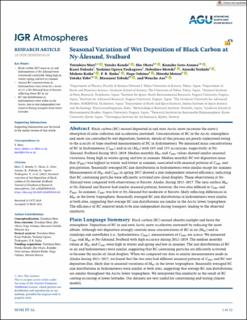Seasonal Variation of Wet Deposition of Black Carbon at Ny-Ålesund, Svalbard
| dc.contributor.author | Mori, Tatsuhiro | |
| dc.contributor.author | Kondo, Yutaka | |
| dc.contributor.author | Ohata, Sho | |
| dc.contributor.author | Goto-Azuma, Kumiko | |
| dc.contributor.author | Fukuda, Kaori | |
| dc.contributor.author | Ogawa-Tsukagawa, Yoshimi | |
| dc.contributor.author | Moteki, Nobuhiro | |
| dc.contributor.author | Yoshida, Atsushi | |
| dc.contributor.author | Koike, Makoto | |
| dc.contributor.author | Sinha, P. R. | |
| dc.contributor.author | Oshima, Naga | |
| dc.contributor.author | Matsui, Hitoshi | |
| dc.contributor.author | Tobo, Yutaka | |
| dc.contributor.author | Yabuki, Masanori | |
| dc.contributor.author | Aas, Wenche | |
| dc.date.accessioned | 2021-06-18T07:18:54Z | |
| dc.date.available | 2021-06-18T07:18:54Z | |
| dc.date.created | 2021-06-17T10:43:12Z | |
| dc.date.issued | 2021 | |
| dc.identifier.citation | Journal of Geophysical Research (JGR): Atmospheres. 2021, 126, e2020JD034110. | en_US |
| dc.identifier.issn | 2169-897X | |
| dc.identifier.uri | https://hdl.handle.net/11250/2760044 | |
| dc.description.abstract | Black carbon (BC) aerosol deposited in and onto Arctic snow increases the snow's absorption of solar radiation and accelerates snowmelt. Concentrations of BC in the Arctic atmosphere and snow are controlled by wet deposition; however, details of this process are poorly understood owing to the scarcity of time-resolved measurements of BC in hydrometeors. We measured mass concentrations of BC in hydrometeors (CMBC) and in air (MBC) with 16% and 15% accuracies, respectively, at Ny-Ålesund, Svalbard during 2012–2019. Median monthly MBC and CMBC values showed similar seasonal variations, being high in winter-spring and low in summer. Median monthly BC wet deposition mass flux (FMBC) was highest in winter and lowest in summer, associated with seasonal patterns of CMBC and precipitation. Seasonally averaged BC size distributions in hydrometeors were similar except for summer. Measurements of MBC and CMBC in spring 2017 showed a size-independent removal efficiency, indicating that BC-containing particles were efficiently activated into cloud droplets. These observations at Ny-Ålesund were compared with observations at Barrow, Alaska, during 2013–2017. The near-surface MBC at Ny-Ålesund and Barrow had similar seasonal patterns; however, the two sites differed in CMBC and FMBC. In summer, CMBC was low at Ny-Ålesund but moderate at Barrow, likely reflecting differences in MBC in the lower troposphere. Seasonally averaged BC size distributions in hydrometeors were similar at both sites, suggesting that average BC size distributions are similar in the Arctic lower troposphere. The efficiency of BC removal tends to be size-independent during transport, leading to the observed similarity. | en_US |
| dc.language.iso | eng | en_US |
| dc.rights | Navngivelse 4.0 Internasjonal | * |
| dc.rights.uri | http://creativecommons.org/licenses/by/4.0/deed.no | * |
| dc.title | Seasonal Variation of Wet Deposition of Black Carbon at Ny-Ålesund, Svalbard | en_US |
| dc.type | Peer reviewed | en_US |
| dc.type | Journal article | en_US |
| dc.description.version | publishedVersion | en_US |
| dc.rights.holder | © 2021. The Authors. | en_US |
| dc.source.pagenumber | 32 | en_US |
| dc.source.volume | 126 | en_US |
| dc.source.journal | Journal of Geophysical Research (JGR): Atmospheres | en_US |
| dc.identifier.doi | 10.1029/2020JD034110 | |
| dc.identifier.cristin | 1916341 | |
| dc.relation.project | NILU: 121002 | en_US |
| dc.source.articlenumber | e2020JD034110 | en_US |
| cristin.ispublished | true | |
| cristin.fulltext | original | |
| cristin.qualitycode | 2 |
Tilhørende fil(er)
Denne innførselen finnes i følgende samling(er)
-
Publikasjoner fra Cristin - NILU [1329]
-
Vitenskapelige publikasjoner [1068]
Vitenskapelige artikler, kapitler og monografier.

